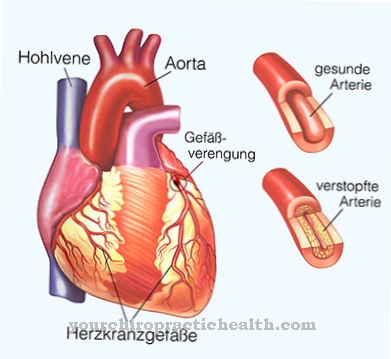The Arm plexus palsy is a mostly traumatic neurological damage to the nerves in the shoulder and arm area. Healing is a lengthy process which often does not end in a complete restoration of function.
What is arm plexus palsy?

© Alila Medical Media - stock.adobe.com
Arm plexus palsy describes paralysis in the arm and / or shoulder girdle area. It is not a muscular but a neurological deficit, the cause of which is damage to the brachial plexus. As part of the peripheral nervous system, it supplies the chest and shoulder muscles as well as the motor and sensitive arm and hand.
The nerve plexus is formed from the anterior branches of the spinal nerves C5-C8 and Th1. Arm plexus palsy is divided into complete and incomplete paralysis, depending on the extent of the damage. All muscle groups in the shoulder, upper arm, forearm and hand can be partially or completely affected by the functional failure.
causes
Damage to the arm plexus can have various causes. In most cases it is traumatic and is triggered by strong pulling or pressure on the plexus. Traumatic plexus palsy can also occur during childbirth when obstetricians or forceps blades apply excessive pressure on the child's shoulder area.
A mismatch between the child's shoulder and the mother's pelvis in a spontaneous delivery is also a risk factor. In addition to traumatic causes, arm plexus palsy can also be caused by tumors that occupy space. As they grow, these pressure the surrounding tissue and the nerve fibers running in it.
Plexus neuritis is an inflammatory reaction of the peripheral nervous system that occurs after infection or vaccination. It is most common in the shoulder girdle area, where the inflammation can cause neurological failure.
In some cases, arm plexus palsy occurs as a late consequence of radiation therapy, since ionizing radiation can damage the nervous system, as can other tissues in the human body.
You can find your medication here
➔ Medicines against muscle paralysisSymptoms, ailments & signs
The symptoms of arm plexus palsy vary depending on the location and extent of the damage. A distinction is made between an upper and a lower paresis.
The upper plexus palsy or Erb's paralysis is characterized by an internal rotation position of the arm with flaccid muscle tone. The affected vertebral segments are C5 and C6, the exiting nerves of which supply the muscles in the shoulder and upper arm. The elbow extensors remain intact in Erb's palsy.
Lower plexus palsy or Klumpke's palsy affects segments C7 to Th1 and causes muscular deficits in the forearm and hand with involvement of the elbow extensor.
Sensory disturbances usually occur on the outer upper arm and forearm, but are not reported by all those affected. Another symptom is burning pain that radiates into the injured arm and into the hand and fingers. Pain mainly occurs when the nerves in the spinal cord tear out.
An untreated paresis leads in the long term to muscle wasting in the supply area of the affected nerves. The body breaks down the inactive muscles over time, making the damaged arm thinner than the other. In newborns, the arm plexus palsy often resolves on its own, but growth disorders can later occur on the affected arm.
Diagnosis & course
The first step in the diagnosis is a detailed discussion with the attending physician, since conclusions can be drawn from the anamnesis, especially in the case of traumatic paresis. Imaging procedures such as computed tomography or magnetic resonance tomography can detect injuries to bones or soft tissues. If CT and MRI are not sufficient for the diagnosis, myelography offers an exact representation of the spinal cord.
Individual nerves and their injuries can thus be recognized. The prognosis for arm plexus palsy varies depending on the extent. Since the healing of the nerves is a lengthy process, neurological failures cannot be ruled out even after a long period of time.
When should you go to the doctor?
As a rule, the person concerned should contact a doctor if there is severe pain or movement restrictions in the respective body region. The restrictions themselves can also be associated with sensory disorders or paralysis. If these symptoms occur, a doctor must be consulted in any case. A visit to the doctor is particularly necessary in the case of stabbing or burning pain.
In most cases, the patients also suffer from reduced exercise capacity and continue to suffer from severe muscle wasting. Especially after an accident or serious injury, the affected area must be examined by a doctor in order to avoid consequential damage. This is especially true for children as they continue to grow. In this way, consequential damage and further restrictions in adulthood can be avoided. Medical treatment is also necessary in the case of visible growth disorders.
In order not to continue to irritate the affected region, the patient should avoid unnecessary stress or work. As a rule, arm plexus palsy can be treated relatively well with the help of therapies. In some cases, however, the symptoms cannot be completely limited. However, the life expectancy of the patient is not reduced by this disease.
Doctors & therapists in your area
Complications
Arm plexus palsy is neurological nerve damage to the shoulder and arm area. If the fine network of the peripheral nervous system in the chest and shoulder muscles is damaged or acutely inflamed, motor disorders of the arms and hands occur as a result. If the symptoms are not treated in time, the healing process will be extremely difficult.
In some cases, a functional disorder remains as a complication. The pathogenesis of the symptom has various causes. The arm plexus palsy is usually traumatic and can indicate a birth defect or accident. Sometimes the symptom can be a long-term consequence of being bedridden or chemotherapy, but it can also be caused by the growth of a tumor that puts pressure on the surrounding tissue and nerve fibers.
Arm plexus palsy occurs equally in men and women of all ages. Most of those affected have problems in the shoulder girdle. If the symptom is left untreated, serious complications result. The internal rotation position of the arm shifts, symptoms of paralysis and loss of feeling make it difficult to cope with everyday life. Severe, burning pain can radiate from the spinal cord to the fingers.
Muscle wasting occurs and the musculoskeletal system can become visibly deformed. In newborns with birth-related arm plexus palsy, the therapy plan should take effect early, otherwise the affected arm is threatened with growth disorder. Physiotherapy and anti-inflammatory pain medication keep the symptom as low as possible. In the case of very advanced arm plexus palsy, surgical intervention is required.
Treatment & Therapy
The regeneration of the arm plexus palsy begins with a complete relief of the affected arm in order to avoid pressure or tension on the damaged nerve fibers. If this is not sufficient, surgical intervention is indicated. The torn nerve endings are reconnected with a nerve suture, in some cases a transplant is necessary.
This procedure is very complex and should therefore only be performed by an experienced surgeon. If there is an open injury, the supply of the plexus is in principle secondary to the wound and vascular supply. Physiotherapeutic exercises prevent the muscles from breaking down and keep the joints flexible. A regular exercise program reduces bad posture and maintains the symmetry of the body.
An abduction splint is used in conservative therapy to facilitate nerve regeneration through optimal positioning. In the case of pain, drug-based pain-relieving therapy is also indicated. Plexus palsy in a newborn requires an intensive therapeutic procedure so that the child can fully develop the function of the affected arm. The parents are intensively involved in the therapy and are encouraged to perform the exercises with the child on a regular basis.
Outlook & forecast
The prognosis for arm plexus palsy is poor. A complete cure and freedom from symptoms are not given with the current medical possibilities.
The damage to the nerve plexus is irreversible and cannot be completely corrected despite the latest technology. With optimal care of the arm and shoulder, the complaints are relieved to a significant extent. In addition, the patient is encouraged to work actively to improve his or her well-being. This includes, in particular, relief of the shoulder and arm.
Possible incorrect posture must be corrected and targeted training can be used to optimize movement sequences. These training units are to be carried out independently at regular intervals even after the treatment has been completed.
In addition, the patient must learn that other areas of the body are not overloaded. Despite all efforts, the arm plexus palsy will not completely resolve. Impairments will be lifelong and these will affect the patient's everyday life. Certain physical loads are no longer possible, so that, under certain circumstances, there may also be professional changes.
The health interference can also increase in intensity. If there is further damage to the nerve plexus or if the patient behaves counterproductively, an increase in symptoms in the shoulder and arm is to be expected. The physical performance level continues to decline.
You can find your medication here
➔ Medicines against muscle paralysisprevention
The arm plexus paresis caused by an accident can only be prevented with sufficient caution in dangerous situations. Comprehensive training for obstetricians reduces the risk of nerve damage during childbirth, but in some cases, especially with spontaneous delivery or complications, paresis of the child's brachial plexus occurs.
Since the arm plexus palsy is caused by strong pulling or pressure on the emerging nerve fibers, it is important to ensure correct positioning, especially for bedridden people or during long operations.
Aftercare
Since the nerves in the shoulder and arm were relatively severely damaged by the arm plexus palsy, the patient's arm must be completely relieved after the accident. This means that the person concerned must no longer expose himself to unnecessary stress and must protect his entire body. The functioning of the arm can only be restored through complete protection.
After a surgical procedure, the person affected must also recover and allow the wound to heal properly. Furthermore, in the case of arm plexus palsy, physiotherapy measures are also necessary to get the arm used to stress again and to restore the arm's movement. If the arm plexus palsy already occurs in a child, the parents must motivate the child to physiotherapy and to the various exercises.
The disease can only be completely cured through regular exercise. Often those affected are also dependent on taking medication that is supposed to promote healing. Contact with other people affected by the disease can also have a positive effect on the course and possibly avoid psychological complaints.
If the arm plexus palsy also leads to paralysis, those affected are dependent on help in everyday life, whereby the help from friends and family has proven to be very positive.
You can do that yourself
In the case of arm plexus palsy, patients can generally do little to counter the causes of the paralysis. However, you can help speed recovery.
In particular, it is important to completely relieve the affected limb in order to prevent renewed pressure or tension on the damaged nerve fibers. If the doctor prescribes an abduction splint, it should be worn. The splint optimally supports the affected arm and the damaged nerves and thus accelerates regeneration. The affected limb must be spared. Patients should never do heavy physical work and, if still possible, should not use the affected arm to type on keyboards or on the mobile phone.
Through physiotherapeutic exercises, the breakdown of the muscles can be prevented, and the joints also remain flexible. Patients should have an exercise plan drawn up and train consistently. Healing from arm plexus palsy takes a long time, so rapid progress is not expected.
If the paralysis was caused by an accident, great caution should be exercised in future when exercising and doing hazardous work. Work safety regulations must be strictly observed. If these are insufficient, those affected should inform their superiors and, if necessary, consult the works council.

























.jpg)

.jpg)
